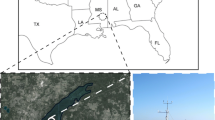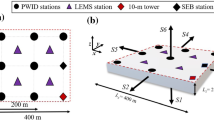Abstract
According to the cross coupling theorem of atmospheric turbulence, latent heat flux comprises two components, a vertical humidity gradient flux and a coupling flux of vertical velocity. In this paper, observational data are employed to demonstrate and analyze the coupling effect of vertical velocity on latent heat flux. The results highlight the presence of a coupling zero-effect height. When the observational level exceeds or underlies the coupling zero-effect height, the coupling effect suppresses or enhances the latent heat flux, respectively. Above the heterogeneous terrain in the experimental region, the overall difference between the estimated and the observed latent heat fluxes decreases from 27% to 2% (for ascending flow) and from 47% to 28% (for descending flow), after compensating for gradient flux. The coupling theorem of atmospheric turbulence is well validated by our analysis, supporting a role for experimental datasets in unraveling the mysteries of atmospheric turbulence.
Similar content being viewed by others
References
Monin A S, Obukhov A M. Basic turbulent mixing laws in the at mospheric surface layer. Tr Akad Nauk SSSR Geofiz Inst, 1954, 24: 163–187
Baldocchi D, Falge E, Gu L, et al. FLUXNET: A new tool to study the temporal and spatial variability of ecosystem-scale carbon dioxide, water vapor, and energy flux densities. Bull Amer Meteorol Soc, 2001, 82: 2415–2434
Baldocchi D D. Assessing the eddy covariance technique for evaluating carbon dioxide exchange rates of ecosystems: Past, present and future. Glob Change Biol, 2003, 9: 479–492
Black T A, den Hartog G, Neumann H H, et al. Annual cycles of water vapour and carbon dioxide fluxes in and above a boreal aspen forest. Glob Change Biol, 1996, 2: 219–229
Segal M, Avissar R, McCumber M C, et al. Evaluation of vegetation effects on the generation and modification of mesoscale circulations. J Atmos Sci, 1988, 45: 2268–2292
Mahrt L, Sun J, Vickers D, et al. Observations of fluxes and inland breezes over a heterogeneous surface. J Atmos Sci, 1994, 51: 2484–2499
Sun J, Desjardins R, Mahrt L, et al. Transport of carbon dioxide, water vapor and ozone over Candle Lake. J Geophys Res, 1997, 103: 25873–25885
Finnigan J J, Brunet Y. Turbulent airflow in forests on flat and hilly terrain. In: Coutts, M P, Grace J, eds. Wind and Trees, London: Cambridge University Press, 1995
Lee X. On micrometeorological observations of surface-air exchange over tall vegetation. Agric For Meteorol, 1998, 91: 39–49
Zhang Q, Li H Y. The relationship between surface energy balance unclosure and vertical sensible heat advection over the loess plateau (in Chinese). Acta Phys Sin, 2010, 59: 5888–5895
Webb E K, Pearman G I, Leuning R. Correction of the flux measurements for density effects due to heat and water vapour transfer. Q J R Meteorol Soc, 1980, 106: 85–100
Han B, Lu S, Ao Y. Analysis on the interaction between turbulence and secondary circulation of surface layer in Jinta oasis on summer. Adv Atmos Sci, 2010, 27: 605–620
Hu Y, Chen J. Nonequilibrium thermodynamic theory of the atmospheric turbulence. In: Lang P R, Lombargo F S, ed. Atmospheric Turbulence, Meteorological Modeling and Aerodynamics, New York: Nova Science Publishers Inc, 2009. 59–110
Hu Y. Application of the linear thermodynamics to atmosphere system (I): Linear phenomenological relation and thermodynamic property of the atmosphere. Adv Atmos Sci, 2002a, 19: 448–458
Hu Y. Application of the linear thermodynamics to atmosphere system (II), Exemplification of the linear phenomenological relation in the atmosphere system. Adv Atmos Sci, 2002b, 19: 767–776
Hu Y. The influence of convergence movement on turbulent transportation in the atmospheric boundary layer. Adv Atmos Sci, 2003, 20: 794–798
Onsager L. Reciprocal relations in irreversible processes I. Phys Rev, 1931, 37: 405–426
Onsager L. Reciprocal relations in irreversible processes II. Phys Rev, 1931, 38: 2265–2279
Oncley S P, Foken T, Vogt R, et al. The Energy Balance Experiment EBEX-2000. Part I: Overview and energy balance. Bound-Layer Meteor, 2007, 123: 1–28
Chen J, Hu Y, Zhang L. Principle of cross coupling between vertical heat turbulent transport and vertical velocity and determination of cross coupling coefficient. Adv Atmos Sci, 2007, 24: 89–100
Businger J A, Wyngaard J C, Izumi Y, et al. Flux-profile relationships in the atmospheric surface layer. J Atoms Sci, 1971, 28: 181–189
Dyer A J. A review of flux-profile-relationships. Bound-Layer Meteor, 1974, 7: 363–372
Högström U. Non-dimensional wind and temperature profiles in the atmospheric surface: A re-evaluation. Bound-Layer Meteor, 1988, 42: 55–78
Högström U. A critical evaluation of the aerodynamical error of a turbulence instrument. J Appl Meteorol, 1982, 21: 1838–1844
Deacon E L. The levelling error in Reynolds stress measurement. Bull Amer Meteorol Soc, 1968, 49: 836
Kaimal J C, Haugen D A. Some errors in the measurement of Reynolds stress. J Appl Meteorol, 1969, 8: 460–462
Wilczak J M, Oncley S P, Stage S A. Sonic anemometer tilt correction algorithms. Bound-Layer Meteor, 2001, 99: 127–150
Author information
Authors and Affiliations
Corresponding author
Rights and permissions
About this article
Cite this article
Chen, J., Hu, Y., Lü, S. et al. Experimental demonstration of the coupling effect of vertical velocity on latent heat flux. Sci. China Earth Sci. 56, 684–692 (2013). https://doi.org/10.1007/s11430-012-4574-1
Received:
Accepted:
Published:
Issue Date:
DOI: https://doi.org/10.1007/s11430-012-4574-1




